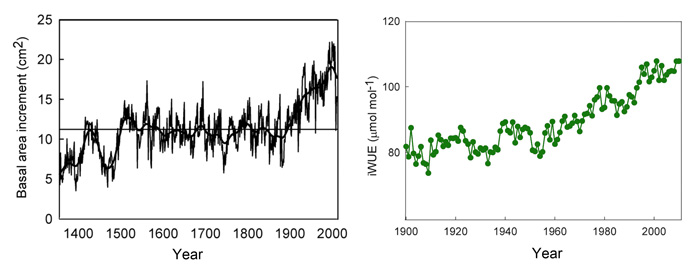| Follow @co2science |
Paper Reviewed
Urrutia-Jalabert, R., Malhi, Y., Barichivich, J., Lara, A., Delgado-Huertas, A., Rodríguez, C.G. and Cuq, E. 2015. Increased water use efficiency but contrasting tree growth patterns in Fitzroya cupressoides forests of southern Chile during recent decades. Journal of Geophysical Research, Biogeosciences 120: 2505-2524.
Climate alarmists have long claimed that global warming will negatively impact Earth's ecosystems, including old-growth forests, where it is hypothesized that these woodland titans of several hundred years age will suffer decreased growth and increased mortality in consequence of predicted future increases in temperature and drought. However, others see the situation as not so dire. In fact, their view is quite the opposite -- one in which trees are enhanced by the aerial fertilization effect of rising atmospheric CO2 concentrations, which effect is expected to increase growth and make trees less susceptible to the deleterious effects of drought.
So which vision of the future appears most likely to be coming about? According to the seven member research team of Urrutia-Jalabert et al. (2015), the much more optimistic future is the one that is looking bright.
Working in the Andean Cordilleras region of southern Chile, Urrutia-Jalabert et al. performed a series of analyses on tree ring cores they obtained from long-lived Fitzroya cupressoides stands, which trees they say "may be the slowest-growing and longest-lived high biomass forest stands in the world."
Focusing on two of the more pertinent findings of their study, as shown in Figure 1 below, both the basal area increment (a surrogate for aboveground woody biomass accumulation) and intrinsic water used efficiency (a measure of drought resistance) of Fitzroya experienced dramatic increases over the past century. Commenting on these trends, the authors write "the sustained positive trend in tree growth is striking in this old stand, suggesting that the giant trees in this forest have been accumulating biomass at a faster rate since the beginning of the [20th] century." And coupling that finding with the 32 percent increase in water use efficiency over the same time period, Urrutia-Jalabert et al. conclude the trees "are actually responding to environmental change." Indeed they are, and magnificently well!
With respect to the cause of these favorable findings, the researchers state "we believe that this increasing growth trend...has likely been driven by some combination of CO2 and/or surface radiation increases," adding that "pronounced changes in CO2 have occurred in parallel with changes in climate, making it difficult to distinguish between both effects." Thus, it is clear that of the two views predicting the future of old-growth forests, the most likely to occur (and which is actually occurring in the southern Chilean Andes) is the one in which the benefits of CO2 win out over model projections of climate-induced demise.

Figure 1. Basal area increment chronology (left panel, AD 1355-2010) and intrinsic water use efficiency (right panel, AD 1900-2010) of long-lived Fitzroya cupressoides trees in the Andean Cordilleras of southern Chile.




